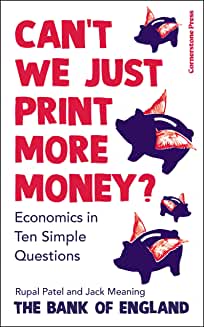Book Review: Rupal Patel and Jack Meaning, ‘Can’t we just print more money – Economics in ten simple questions’, Cornerstone Press, London, May 2022.

Introduction
The Bank of England is the first central bank to carry out the set of functions which are today associated with a central bank. It is not the oldest, an honour which goes to the Riksbank established in 1668. After its establishment in 1694 as an issuer of currency and as a government bank, the Bank of England started adding functions over the years. It was only in the second half of the 19th century, when it became a lender of last resort, that the Bank of England came to be acknowledged and regarded as a central bank.
One of the earliest works on central banking is Lombard Street by Walter Bagehot. His father-in-law, James Wilson, was incidentally the first Finance Member of British India (see my post on James Wilson here). Bagehot uses the term central bank only twice in his book. Even in one of these, he qualifies it by saying central bank or banks as if there could be more than one.
From around this period, the role of a central bank in maintaining financial stability became important. Bagehot considered the lender of last resort function of a central bank as its most important and defining characteristic. Along with this, the way a central bank communicates with the rest of the financial system and the public at large also became important. In fact, my favourite anecdote on central bank communication comes from this period.
Economic literacy
Over the last two decades, following many cases of fraud in banks, and banking crises, central banks took upon themselves the onus of educating the public through financial literacy programmes. The Bank of England started many initiatives in this direction to help explain how it works, as well as how the economy works.
Andrew Bailey, the present Governor of the Bank of England, describes himself as a great advocate of economic literacy. In his introduction to the book, he lists some of these initiatives. One such is a ‘Knowledge Bank’ section on the Bank’s website. Then there are the Citizen’s Panels across the UK where the Governor and Deputy Governors take part. Among other things, they explain their decisions at these meetings. The Bank’s extensive education programme introduces young people to the basics of money management and key economic concepts. More than 500 staff of the Bank deliver talks in state schools. Governor Bailey himself speaks often at these schools.
‘Can’t We Just Print More Money’ by Rupal Patel and Jack Meaning, both economists at the Bank of England, is the first such book as part of these initiatives. It tries to explain and demystify the context of the work of the Bank of England. Cornerstone Press, London, an imprint of Penguin Randomhouse, has published the book, copyrighted by the Bank of England. It was typeset in Pondicherry!
Relevance of the book

When I first read about Can’t we just print more money, I was reminded of a comment by a former finance minister from an Indian state. When somebody asked him about the state’s fiscal issues, he denied any such challenge. He further added that in the event of any crisis, we could just print more money. The same evening, a former colleague asked me for my comments. My friend was apparently being bombarded with questions on the subject. I hope he was able to satisfy his friends.
This book is for everyone from the layman to the expert. The layman because the authors build a set of complex ideas from first principles and everyday examples. The expert because they too could do with an overview of simple explanations to complex ideas through current and compelling anecdotes and examples. That is also because the subject has become increasingly complex over the years. As the authors write (page 9): ‘Today’s economists have started to incorporate ideas from sociology, psychology and even biology to achieve a more rounded view of the discipline: one that combines the scientific rigour sought by Marshall with the pluralistic ethos of Aristotle and Smith.’
The book is also relevant as knowledge of economics can impact the lives of people across the board. As the authors write, ‘Economics can make you happier, healthier and wealthier: economic literacy has been shown to improve your life expectancy, mental well-being and lifetime earnings, to name just a few benefits.’ A survey in the UK showed that more than 80 per cent of people said that economics is either very relevant, or relevant, in their everyday lives.
Structure
The book is structured as answers to ten questions. In fact, it is a collection of answers to 51 shorter questions, all grouped into ten chapters. If one were to use one word or expression for each of the ten main chapters, they are as follows: markets, market failures, labour, growth, trade, inflation, money, banking, financial crises, and policy. The chapter titles are of course more elaborate, like the title of the book. The title comes from a chapter on monetary and fiscal policy.
The economy and the markets
The first chapter is titled where does my breakfast come from? It deals with basic concepts such as supply and demand, and how individual decisions impact the economy. It explains what markets are and the power of markets.
Market failures
The title of the second chapter is equally enigmatic: can economics solve climate change? It explains perfect competition and monopolies and how an economy makes its production decisions. The chapter also introduces us to the fundamental problem of information asymmetry, where parties to the same financial transaction have different sets of information. An explanation of how and why markets fail follows. As they quote Salvador Dali, the surrealist painter: you should ‘have no fear of perfection – you’ll never reach it.’
Market failures can also happen because of wrong assumptions. As the British statistician, George Box said, ‘all models are wrong, but some are useful’.
As for the impact on the environment and climate, way back in the 1960s, Garrett Hardin, the American ecologist, called it the Tragedy of the Commons. This concept explains how common land would eventually become overused, degraded, and useless to all. Many others carried forward the work on this. This included Late Elinor Ostrom, the first woman Nobel Laureate in economics.
In the context of climate change, Mark Carney, former Governor of the Bank of Canada and the Bank of England, called this the Tragedy of the Horizons. ‘It is a short-termism that leads to market failures, which creates issues for the future you, and for future generations.’
Labour and wages
Labour, one of the factors of production, is the subject of the third chapter. How are wages decided, what are the frictions in the labour market, and why one must almost always consider going back to school? Will a PhD guarantee a higher wage? Why is it that one of the two authors without a PhD is higher paid than the other with a PhD even though both are economists at the Bank of England?
On reading this, I thought for a while whether it was wise on my part to do a PhD. Back in an earlier job, I did get an extra allowance for doing my PhD. But, that was not why I did it. I enjoyed the process, on the whole, and I am happy that I managed to complete it.
Economic growth
Chapter 4. Concepts relating to economic growth such as GDP and per capita income are the subject of this chapter. Why growth alone may not guarantee happiness? What explains poverty and inequality? Is higher economic growth always good?
Trade
The fifth chapter, titled Why are so many of my clothes made in Asia, deals with international trade. What is comparative advantage, and why do countries trade? The authors compare a triathlete with individual event champions who perform better in each of the events. What are the barriers to trade? The chapter goes on to explain why Switzerland is known for watches, Belgium for beer, and Cuba for cigars. It ends by explaining why Asian countries have in recent years become the main producers of mobile phones, computers and solar panels.
Inflation
The tricky, perennial, most commonly discussed, and politically sensitive issue of inflation is the subject of the next chapter. What is inflation, where does it come from, and how is it calculated? In what way does high inflation affect the society as we saw in Zimbabwe where it became 80 billion per cent? What are the cost-push and demand factors that determine inflation? Around these issues, the chapter introduces us to the concept of monetarism.

Money
Money is the subject of the next chapter. It follows naturally from the previous one. What makes money the money as we know it? In other words, what is the money-ness in money? Where does the money come from, what determines its supply, and why can’t I print my own money? The chapter rounds off with a discussion on the future of money. This is relevant in the current surge of virtual currencies where central banks are also pondering over issuing their own digital currencies.
In this context, the authors discuss the three functions of money: unit of account, medium of exchange, and store of value. They attribute this to Adam Smith, who they call the grandfather of economics. I always thought it was William Stanley Jevons who first articulated these functions in 1875, a century after Adam Smith’s best-known work. I initially thought it might be an error or oversight. But, since they mention it in three places, I went back to two of Smith’s books. Even the short chapter on money in The Wealth of Nations had no reference to the functions. Neither does The Theory of Moral Sentiments. If any of the readers have an idea about the reference where Smith talks about the three functions of money, please post it in the comment section.
Banking
The title of the eighth chapter, Why shouldn’t I hoard all the money under the mattress, is about banking. The reference to the mattress is from an Israeli lady. She surprised her mother by buying her a new mattress that would better support her back. But, little did she know that the old one that she disposed of had one million dollars in cash lined inside. She went from pit to pit across Tel Aviv searching for the old mattress. But that search only wasted more money.
The chapter goes on to discuss the benefits of banking. It shows how banks are fragile, and could also fail. There is a long discussion on how and under what circumstances central banks could save banks. They quote Paul Tucker, former Deputy Governor at the Bank, who wrote an influential book on central banking titled Unelected Power. Tucker summarised Bagehot’s dictum as follows: ‘to avert panic, central banks should lend early and freely (i.e. without limit), to solvent businesses, against good collateral, and at “high rates”’. Banks are of course safer than mattresses to keep your money, but they are not the safest.
Financial crises
That brings us to the ninth chapter, why did no one see the crash coming? That was a question the Queen asked at a building inauguration at the London School of Economics. She aimed it at Luis Garciano, the Spanish economist and politician, who was sitting on the dais. In Garciano’s words, he replied to the Queen that ‘the reason the situation got out of hand is that those working at every point in the lending chain were eager to continue doing the job they were paid to do.’ That was not particularly illuminating. And I have no clue whether the Queen was satisfied.
Through Garciano, the Queen was also addressing the profession, and many in it felt obliged to give their own answers in due course. The authors give a lucid summary of many of these explanations which often start with the South Sea Bubble of the early 18th century. In the process, they explain what are economic crises, what are their costs, and how to spot one coming.
Monetary and fiscal policy
The tenth chapter, from which comes the title of the book, is on policy, mainly monetary policy and fiscal policy. It explains how changes in interest rates get transmitted through various channels to bring about the desired effects on the economy. How do taxation and government spending affect the economy? Can governments keep on spending? What is quantitative easing? Why not keep printing money?
Let me offer a spoiler for the last question on whether we can continuously print more money. The authors answer as follows (p. 257):
“… there’s a limit. If central banks were to continue to print more and more without limit, the result would be too much inflation, with prices rising uncomfortably fast and eroding the value of the newly printed money at too fast a rate – potentially making people worse, not better off.’
Summarising the learnings
The last chapter, the 11th, summarises the learnings and explains how everyone can be an economist. So, the conclusion is that (p. 266):
‘economics matters. And it matters whether you’re used to the formal language of economics or not. In fact, you’ve probably been thinking like an economist for your whole life. Just maybe you didn’t know it.’
So, what is the last advice (p. 268)?
‘…empower yourself to become a better economist. You are the economy and so you have the power to shape it and be shaped by it. Along the way, you might just help create a better society for everyone.’
What else could have been covered?
What else could the book have covered? The book is, of course, just a primer. The aim is to encourage the reader to learn more on her own. All the same, I feel that it could have covered some more of the current challenges, like stagflation.
I am sure many would have liked a separate chapter on foreign exchange markets and what determines exchange rates. And what explains the continuing dominance of the dollar. Will the Euro or the Chinese Yuan replace it? These issues always engage the minds of the intelligent layman.
Also missing is perhaps an introduction to finance. The focus is more on banking maybe because it is a Bank of England publication. But, having said that banking is not the safest place for parking one’s savings, there could have been a separate chapter introducing other alternatives. For instance, securities, mutual funds, insurance, and pension funds. After all, with the Bank’s mandate for financial stability, and since they are also relevant to the chapter on financial crises, I find the omission a bit glaring.
‘Can’t we just print more money’ starts with an explanation of markets and their failures. The readers might, therefore, like to know why London became the biggest financial centre in the world. And how it remains one of the biggest even long after the UK lost its former preeminent position as an Empire where the sun never set.
Concluding remarks
When I wrote at the beginning that Can’t we just print more money is for everyone, that includes finance ministers who think printing notes is the solution to all their ills. In their introduction to the book, the authors write: ‘Our economist’s friend could be forgiven for not knowing why we can’t just endlessly print money’. With a few finance ministers too on the readers’ list, the layman too can comfortably reach for the book without doubt or hesitation.
Let me add one more reason for reading the book. A former Governor of the Bank of England, Mervyn King, said about the Bank’s policies: ‘never apologise, never explain’. Similarly, Alan Greenspan, another distinguished central banker, and former Chair of the Federal Reserve said in an often misquoted quote: ‘If I turn out to be particularly clear, you’ve probably misunderstood what I’ve said.’ That quote is not from the book though.
This means that you might as well devise your own means for deciphering central bank-speak. This book will go a long way in getting you there. You might even like to send a few copies of Can’t we just print more money to the economics-challenged but are nevertheless free with their opinions on everything economic.
© G. Sreekumar, July 2022
For periodical updates across my blogs, subscribe for free at the link below:
https://gsreekumar.substack.com/
![]()
Brilliantly written review Sreekumar. If the review is so good, the book would be a must read I am sure.
Thank you, Alpana. You have always been a source of great encouragement! Cheers and warm regards,